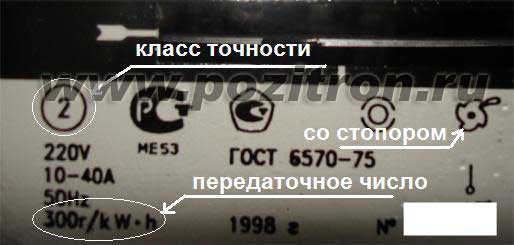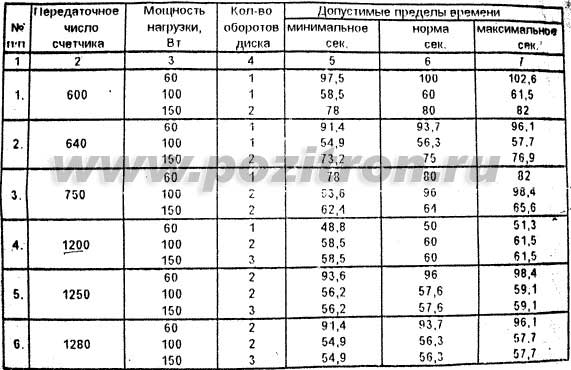Checking the error of the electricity meter, how to check the electricity meter, the procedure for checking the electricity meters (in plain language) ELECTRICAL ENERGY REGULATIONS
If there is a suspicion of inaccuracy in the meter readings or before using it
Its pretty simple to check.
If the meter is to be used for commercial accounting,
It must be verified in the relevant organizations with the sealing of its body.
Each counter has its own accuracy class, which is specified on its panel.
The accuracy class is the maximum permissible deviation of the counter reading
From the true value of the consumed electricity in percent.
That is, with an accuracy class of 2 and a consumed energy of 100 watts,
The counter can count 98 ... 102 watts, and this will be the norm for this counter.
That is, to check the error, it is necessary to include in the network a previously known load,
For example 1 kilowatt, for a certain time, for example 1 hour, and see
How much the meter reading will change in this time.
In our case, for 1 hour, the load of 1 kW will "wind" on the meter of 1 kWh.
During measurements, the mains voltage should be close to 220 volts!
Otherwise, the power consumption and readings will vary
Three-phase meters are tested similarly, only the load is considered to be common, for all phases.
Quite often such a malfunction of meters as "self-propelled" occurs.
Its presence is not permissible!
For detection it is necessary to disconnect the automatic machines, which depart from the counter,
Not turning off the opening, wait a couple of minutes, look at the disc, it should stand.
If your settlement counter shows values different from the norm, you should estimate the error.
And if it is more nominal, give an application to the power supply to replace the meter (at their expense)
Fig.
An example of the type of meter panel.

Induction counters (with a disk) can be checked by counting the revolutions of the disk
For a certain period of time, taking into account the transfer number of the meter.
The gear ratio is the number of revolutions per 1 kWh of electric power.
It is indicated on the panel.
Fig.
Permissible limits of disk rotation time for single-phase meters of accuracy class 2.5
With different gear ratios at a mains voltage of 220 ... 230 volts.

Accuracy class of Measuring Current Transformers for connection of rated
Electricity meters, should be no more than 0.5.
ELECTRICITY ENERGY REGULATIONS
1. Introduction
These "Rules for the accounting of electrical energy" (hereinafter the Rules) are developed in pursuance of the Resolution of the Government of the Russian Federation of 02.11.95 N 1087 "On Urgent Energy Efficiency Measures" by the specialists of the Ministry of Fuel and Energy of Russia, the Ministry of Construction of Russia and RAO UES of Russia with the participation of the State Standard of Russia.
The Rules take into account the provisions of the Civil Code of the Russian Federation (articles 541-544), federal laws "On Ensuring the Unity of Measurements", "On Energy Saving" and other applicable laws of the Russian Federation, GOSTs, normative and technical documents and accumulated experience in the field of electricity metering.
The rules determine the general requirements for the organization of electricity metering and the relationship between the main normative and technical documents in force in this area.
The rules are valid on the territory of the Russian Federation and are compulsory for:
- realization of production, transmission, distribution and consumption of electric energy;
- implementation of design, installation, commissioning and repair work on the organization of electricity metering;
- Maintenance of operation of means of the account of electric energy.
The rules contain the main provisions for the accounting of electricity during its production, transmission, distribution and consumption at existing, newly constructed and reconstructed electrical installations, as well as the operation of metering equipment.
2. General Provisions
2.1. The main purpose of electricity metering is to obtain reliable information on the production, transmission, distribution and consumption of electricity in the wholesale and retail electricity markets for the solution of basic technical and economic tasks:
- financial calculations for electricity and capacity between market participants (energy supply organizations, consumers of electricity), taking into account its quality;
- determination and forecasting of technical and economic indicators of production, transmission and distribution of electric power in power systems;
- Definition and forecasting of technical and economic indicators of electric power consumption at industrial, transport, agricultural, communal and household sectors, etc .;
- Ensuring energy saving and managing power consumption.
2.2. The quality of energy supplied by the energy supply organization must comply with the requirements established by state standards and other mandatory rules or stipulated in the energy supply contract.
2.3. Accounting for active electricity should provide the determination of the amount of electricity (and, if necessary, average power values):
- Generated by power plant generators;
- consumed for own and economic needs (separately) of power stations and substations, as well as for the production needs of the power system;
- released to consumers on the lines departing from the buses of power plants directly to consumers;
- transferred to the network of other owners or received from them;
- released to consumers from the power grid;
- transferred for export and received for import.
The organization of the account of the active electric power should provide an opportunity:
- determination of electric power supply to electrical networks of different voltage classes of power systems;
- compilation of energy balances for self-supporting units of power systems and consumers;
- control over the consumers' compliance with the consumption and energy balances set by them;
- consumer payments for electricity at current tariffs, including multi-rate and differentiated;
- power management.
2.4. Accounting for reactive power should provide the ability to determine the amount of reactive electricity received by the consumer from the electricity supply organization or transferred to it, if these data are used to calculate or control compliance with the specified operating mode of the compensating devices.
2.5. The account of the electric power is made on the basis of measurements with the help of electric energy meters and information-measuring systems.
2.6. To measure electricity, measuring instruments should be used, the types of which are approved by the State Standard of Russia and included in the State Register of Measuring Instruments.
2.7. State metrological control and supervision over measuring instruments used in electricity metering is carried out by the bodies of the State Standard of Russia and the metrological services accredited by it on the basis of the current regulatory documentation.
3. Organization of electricity metering
3.1. The organization of electricity metering for existing, newly constructed, reconstructed electrical installations should be carried out in accordance with the requirements of the current regulatory and technical documents in the part:
- installation sites and volumes of electricity metering devices at power stations, substations and consumers;
- accuracy classes of meters and measuring transformers;
- placement of meters and the implementation of wiring to them.
3.2. Accounting for active and reactive energy and power, as well as quality control of electricity for settlements between the energy supply organization and the consumer, is usually made at the boundary of the balance of the electricity network.
3.3. To increase the efficiency of electricity metering in electrical installations, it is recommended to use automated systems for accounting and control of electricity generated on the basis of electricity meters and information and measuring systems.
3.4. Persons who perform work on the installation and adjustment of electricity metering equipment must have a license to conduct these types of work received in accordance with the established procedure.
3.5. The means of recording electrical energy and controlling its quality should be protected from unauthorized access to exclude the possibility of distortion of measurement results.
4. Organization of operation of electricity meters
4.1. The supplier of measuring instruments used to record electricity and control its quality must have a license for their manufacture, repair, sale or rental, issued by the State Standard of Russia in accordance with the established procedure.
4.2. The organization of the operation of electricity metering devices should be conducted in accordance with the requirements of the current regulatory and technical documents and instructions of manufacturers.
4.3. Maintenance of metering equipment must be carried out by specially trained personnel.
4.4. At maintenance of means of the account of the electric power organizational and technical actions on maintenance of safety of works in accordance with the current rules should be carried out.
4.5. Offices can, based on existing legal and regulatory documents, develop and approve, within their competence, departmental regulatory and technical documents in the field of electricity metering that do not contradict these rules.
4.6. Periodic verification of measuring instruments used to account for electrical energy and control its quality should be performed within the timeframe established by Gosstandart of Russia.
4.7. Permutation, replacement, as well as changing the scheme of inclusion of inventory, is carried out with the consent of the energy supplying organization.
application
Basic terms and definitions used in the text of the Rules
Electrical installations are a set of machines, apparatuses, power lines and auxiliary equipment (together with the facilities and premises in which they are installed) intended for the production, transformation, transformation, transmission, distribution of electrical energy and its transformation into another kind.
Counters that take into account active electricity are called active energy meters (hereinafter counters).
Meters that take into account the integrated reactive power (hereinafter - reactive electricity) for the accounting period are called reactive energy meters.
Means of accounting - a set of devices that provide the measurement and recording of electricity (current and voltage measuring transformers, electric energy meters, telemetric sensors, information and measurement systems and their communication lines) and interconnected in accordance with the established scheme.
Electricity consumption for own needs of power plants and substations is the consumption of electricity by receivers that provide the necessary conditions for the operation of power plants and substations in the technological process of generation, conversion and distribution of electric energy.
Electricity consumption for household needs of power plants and electric grids is the consumption of electricity by auxiliary and non-industrial units on the balance of electric power plants and electric grid companies necessary for servicing the main production, but not directly related to technological processes for the production of thermal and electric power in power plants, and Transmission and distribution of electrical energy.
Electricity consumption for production needs is the consumption of electricity by district boiler houses and electric-boiler installations, both on an independent balance sheet and on the balance of power plants, as well as on the pumping of water by pumped storage power plants and pumping units.
The consumer (subscriber) of electric energy is a legal entity that uses electric energy (capacity).
An energy supply organization is a commercial organization, regardless of its organizational and legal form, which sells electricity or heat produced or purchased to consumers.
Metrological service - a set of subjects of activity and types of work aimed at ensuring the uniformity of measurements.
Metrological control and supervision - the activity carried out by the state metrology body Service (state metrological control and supervision) or metrological service of a legal entity in To check compliance with established metrological rules and norms.
Means of measurement - a technical device designed for measurement.
Verification of measuring instruments - a set of operations performed by metrological service authorities (other authorized bodies and organizations) to determine and confirm the conformity of the measuring instrument with the established technical requirements.
Calibration of measuring instruments is a set of operations performed to determine and confirm the actual values of metrological characteristics and (or) the suitability for the use of a measuring instrument that are not subject to state metrological control and supervision.
The certificate of approval of the type of measuring instrument is a document issued by an authorized state body that certifies that this type of measuring instrument is approved in accordance with the procedure provided for by the current legislation and meets the established requirements.
Accreditation for the right to verify the measuring instruments is an official recognition by the authorized state body of the authority to perform verification work.
The license for manufacturing (repair, sale, rental) of measuring instruments is a document certifying the right to engage in these types of activities, issued to legal entities and individuals by the state metrological service body.


Comments
Commenting on, remember that the content and tone of your message can hurt the feelings of real people, show respect and tolerance to your interlocutors even if you do not share their opinion, your behavior in the conditions of freedom of expression and anonymity provided by the Internet, changes Not only virtual, but also the real world. All comments are hidden from the index, spam is controlled.